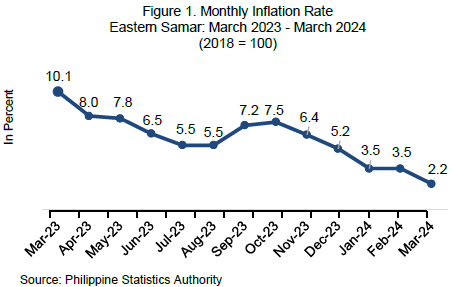 Inflation Rate (IR) in Eastern Samar decelerated to 2.2 percent in March 2024. This rate is 1.3 percentage points lower compared with the 3.5 percent IR posted in February 2024 and 7.9 percentage points lower compared with the 10.1 percent IR in the same month last year.
Inflation Rate (IR) in Eastern Samar decelerated to 2.2 percent in March 2024. This rate is 1.3 percentage points lower compared with the 3.5 percent IR posted in February 2024 and 7.9 percentage points lower compared with the 10.1 percent IR in the same month last year.
The Province’s inflation rate is 1.2 percentage points lower than the 3.4 percent IR recorded in Region VIII and 1.5 percentage points lower than the 3.7 percent national average IR in March 2024.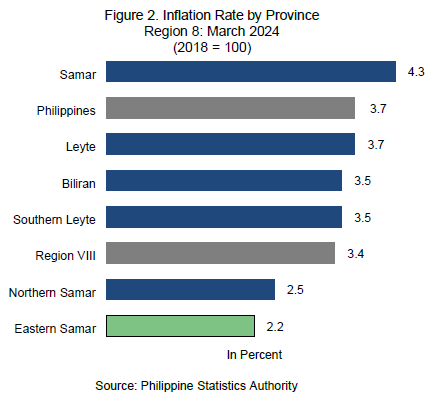
Among the provinces in Region VIII, Samar posted the highest IR at 4.3 percent followed by Leyte at 3.7 percent, and Biliran and Southern Leyte, both at 3.5 percent.
On the other hand, the province of Eastern Samar registered the lowest IR at 2.2 percent followed by Northern Samar at 2.5 percent.
Month-on-Month
The slowing down of the inflation rate to 2.2 percent in March 2024 in the Province was mainly due to the deceleration of inflation rate of Housing, Water, Electricity, Gas and Other Fuels to a deflation of 2.5 percent from 3.3 percent in the previous month. In particular, faster deceleration in the price levels of Electricity (-29.3 percent) and Actual rentals paid by tenants for main residence (5.3 percent) were reported. In addition, the heavily-weighted Food, under the Food and Non-Alcoholic Beverages group, and Alcoholic Beverages and Tobacco contributed to the downtrend of the March 2024 IR, as it decelerates to 3.6 percent and 5.5 percent, respectively from 4.3 percent and 7.3 percent, respectively in the previous month.
Similarly, Restaurants and Accommodation Services; Furnishings, Household Equipment and Routine Household Maintenance; and Health recorded slower inflation rates of 1.5 percent, 6.0 percent, and 2.0 percent, respectively in March 2024.
On the other hand, Clothing and Footwear; Transport; Information and Communication; Recreation, Sport and Culture; and Personal Care, and Miscellaneous Goods and Services accelerated to 3.9 percent, -0.7 percent, 3.1 percent, 5.3 percent, and 3.3 percent, respectively in March 2024.
Meanwhile, Education Services; and Financial Services maintained its previous month’s IR, both at 0.0 percent this month.
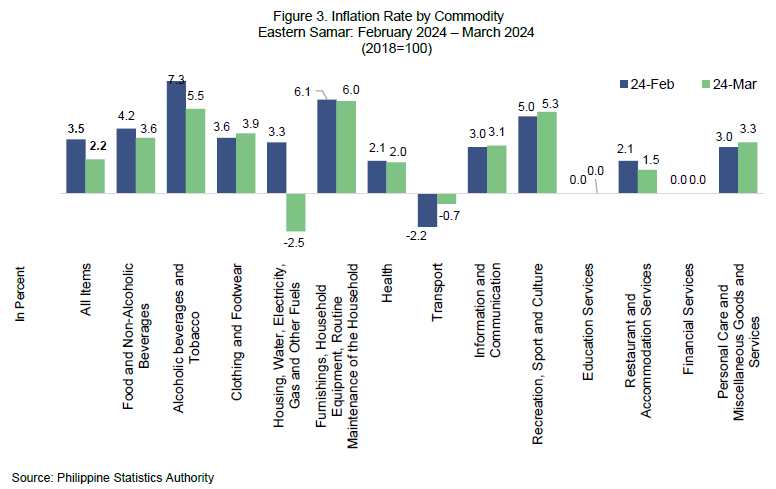
By Commodity Group
For the month of March 2024, deceleration in inflation rates were noted in almost all commodity groups compared to their records in March 2023. Decrease in inflation rates were noted in Restaurants and Accommodation Services (1.5 percent); Housing, Water, Electricity, Gas and Other Fuels (-2.5 percent); Food and Non-Alcoholic Beverages (3.6 percent); Health (2.0 percent); Clothing and Footwear (3.9 percent); Personal Care and Miscellaneous Goods and Services (3.3 percent); Alcoholic Beverages and Tobacco (5.5 percent); Furnishings, Household Equipment and Routine Household Maintenance (6.0 percent); Information and Communication (3.1 percent); Education Services (0.0 percent); and Recreation, Sport and Culture (5.3 percent).
On the other hand, only Transport recorded an increase in inflation rate in March 2024 to -0.7 percent from its record in March 2023 of -1.2 percent.
Only Financial Services maintained in March 2024 its inflation rate of 0.0 percent.
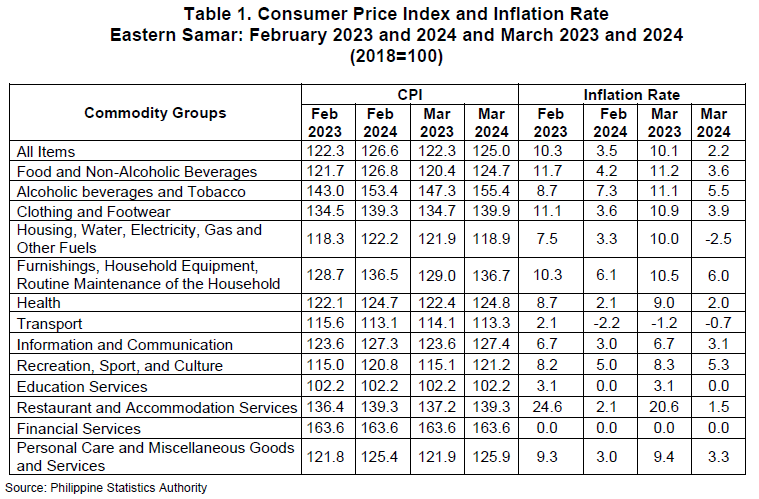
Purchasing Power of Peso (PPP)
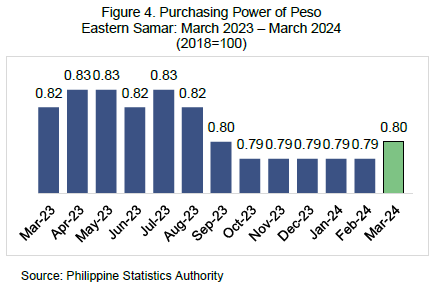 For this month, the Purchasing Power of Peso (PPP) in Eastern Samar strengthened to PhP 0.80 in March 2024 from a PPP of PhP 0.79 in the previous month. This indicates that a peso in 2018 has a value of 80 centavos in March 2024.
For this month, the Purchasing Power of Peso (PPP) in Eastern Samar strengthened to PhP 0.80 in March 2024 from a PPP of PhP 0.79 in the previous month. This indicates that a peso in 2018 has a value of 80 centavos in March 2024.
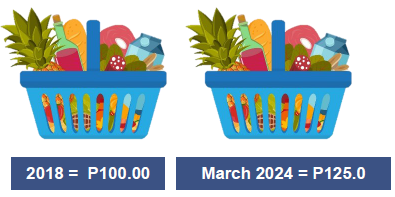 In March 2024, Eastern Samar has a CPI of 125.0. This means that a typical household in Eastern Samar needs about PhP 125.00 in March 2024 in order to buy the same basket of goods and services worth PhP 100.00 in 2018.
In March 2024, Eastern Samar has a CPI of 125.0. This means that a typical household in Eastern Samar needs about PhP 125.00 in March 2024 in order to buy the same basket of goods and services worth PhP 100.00 in 2018.
Purchasing Power of Peso (PPP) by Province
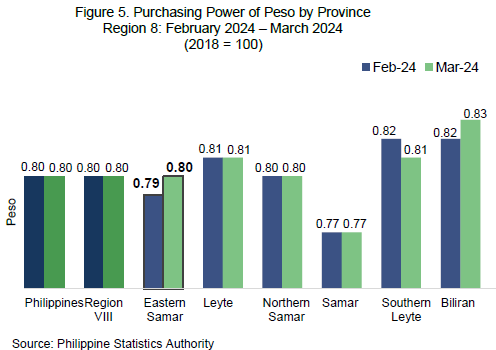
Across the provinces in Region VIII, Biliran had the strongest PPP of PhP 0.83 in March 2024. This was followed by Southern Leyte and Leyte, both with a PPP of PhP 0.81. On the other hand, Samar recorded the weakest PPP at PhP 0.77, followed by Eastern Samar and Northern Samar with a PPP of PhP 0.80 in March 2024.
Only the provinces of Biliran, Southern Leyte, and Leyte exceeded the national and regional average PPP of PhP 0.80.
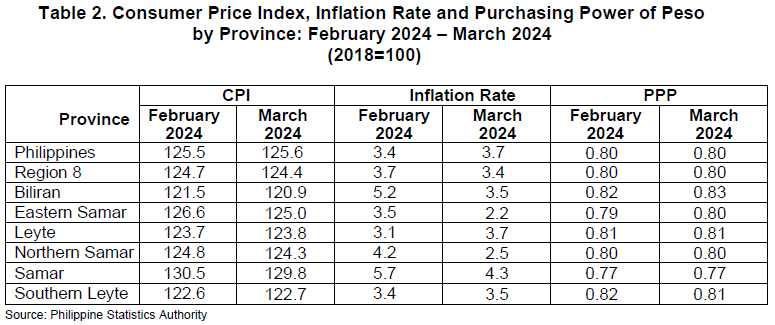
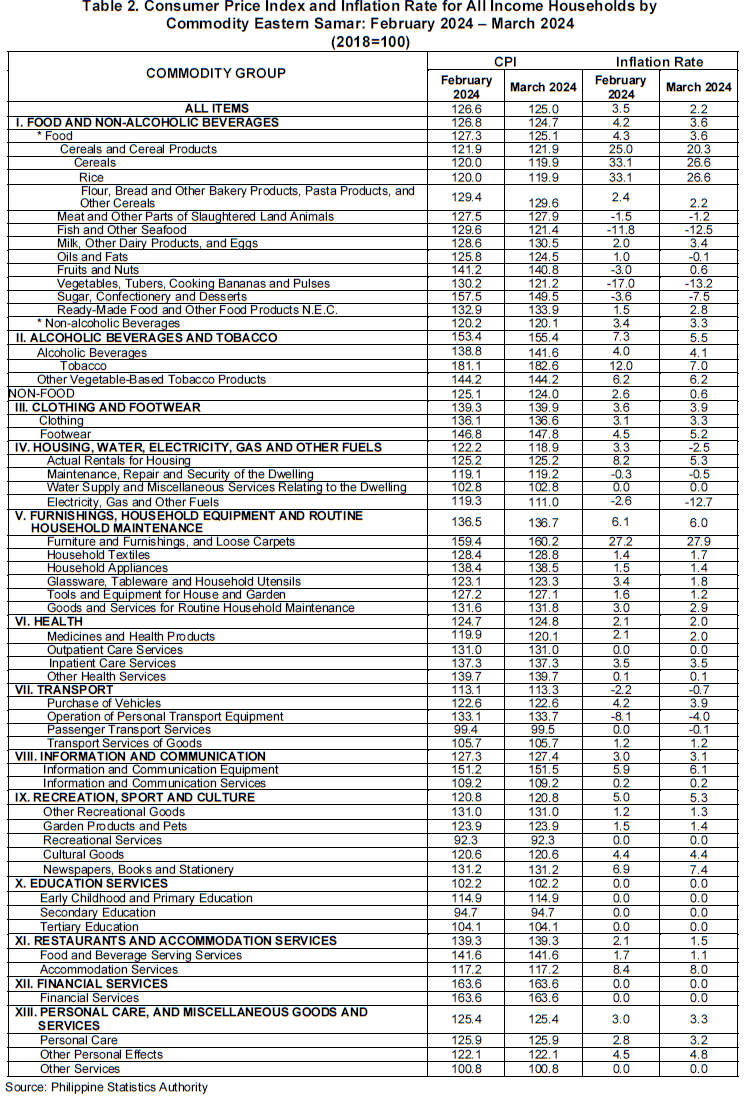
TECHNICAL NOTES
Consumer Price Index (CPI) - is an indicator of the change in the average retail prices of a fixed basket of goods and services commonly purchased by households relative to a base year. It shows how much on the average, prices of goods and services have increased or decreased from a reference period known as the base year. The current CPI series is 2012-based.
The 2012 FIES expenditure data were used to directly estimate the 2012 CPI weights at the national and regional levels. However, the 2012 FIES estimates for the expenditure data at the provincial level were not directly utilized in estimating the CPI expenditure weights as the data at the provincial/city level may not be reliable with the use of the households' master sample (MS) that was utilized in selecting the 2012 FIES sample households. The MS was drawn using regions as domains in generating estimates in all the household surveys of the PSA starting July 2003. The provincial/city expenditure data were derived using the model-based method in small area estimation procedures using the regional expenditure data as the control total for all the expenditure data within the specific region. Using these estimates, the weight for each item of expenditure is computed as a proportion of that item of expenditure to the total national expenditure. A raking procedure was done to adjust the weights of the provinces so that the provincial weights when added up will equal to the regional weights.
The formula used in computing the CPI is the weighted arithmetic mean of price relatives, a variant of the Laspeyres formula with fixed base year period weights as shown below:
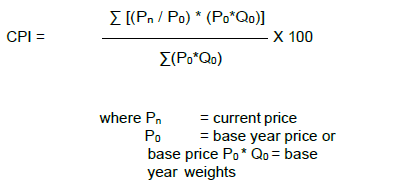
Base Period or Base Year - is the period, usually a year, at which the index number is set to 100. It is the reference point of the index number series.
Market Basket - is a term used to refer to a sample of goods and services that are commonly purchased and bought by an average Filipino household.
Inflation Rate (IR) - is defined as the annual rate of change or the year-to-year change in the CPI and is computed as:
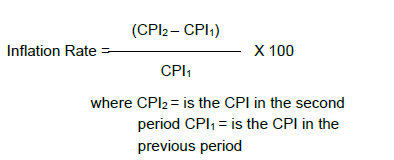
Purchasing Power of the Peso (PPP) - is a measure of the real value the peso in a given period relative to a chosen reference period. It is computed by getting the reciprocal of the CPI and multiplying the result by 100.
SGD. RONNIE A. BAJADO
Chief Statistical Specialist

